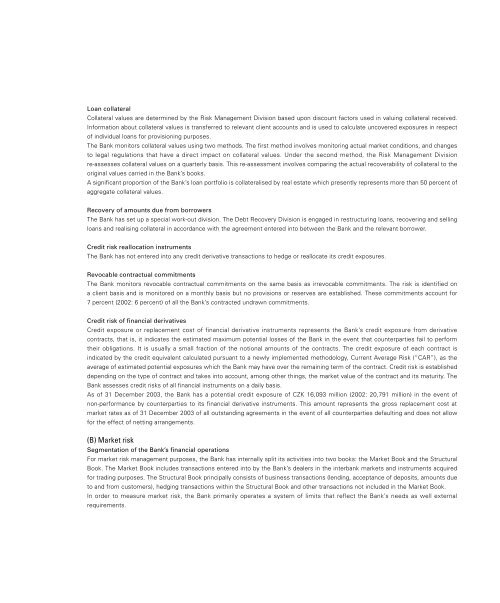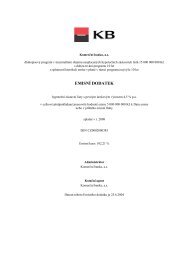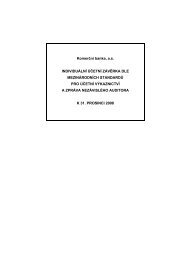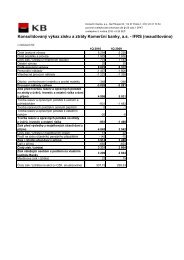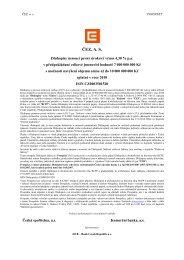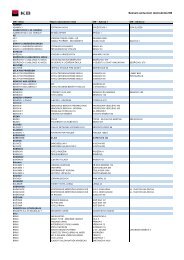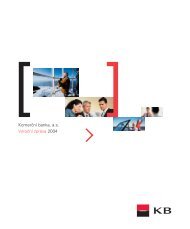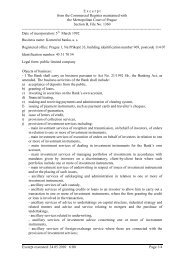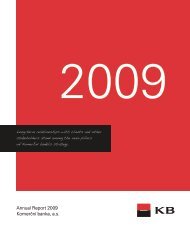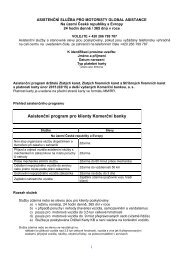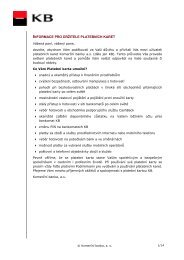KB prezent. angl - Komerční banka
KB prezent. angl - Komerční banka
KB prezent. angl - Komerční banka
You also want an ePaper? Increase the reach of your titles
YUMPU automatically turns print PDFs into web optimized ePapers that Google loves.
Loan collateral<br />
Collateral values are determined by the Risk Management Division based upon discount factors used in valuing collateral received.<br />
Information about collateral values is transferred to relevant client accounts and is used to calculate uncovered exposures in respect<br />
of individual loans for provisioning purposes.<br />
The Bank monitors collateral values using two methods. The first method involves monitoring actual market conditions, and changes<br />
to legal regulations that have a direct impact on collateral values. Under the second method, the Risk Management Division<br />
re-assesses collateral values on a quarterly basis. This re-assessment involves comparing the actual recoverability of collateral to the<br />
original values carried in the Bank’s books.<br />
A significant proportion of the Bank’s loan portfolio is collateralised by real estate which presently represents more than 50 percent of<br />
aggregate collateral values.<br />
Recovery of amounts due from borrowers<br />
The Bank has set up a special work-out division. The Debt Recovery Division is engaged in restructuring loans, recovering and selling<br />
loans and realising collateral in accordance with the agreement entered into between the Bank and the relevant borrower.<br />
Credit risk reallocation instruments<br />
The Bank has not entered into any credit derivative transactions to hedge or reallocate its credit exposures.<br />
Revocable contractual commitments<br />
The Bank monitors revocable contractual commitments on the same basis as irrevocable commitments. The risk is identified on<br />
a client basis and is monitored on a monthly basis but no provisions or reserves are established. These commitments account for<br />
7 percent (2002: 6 percent) of all the Bank’s contracted undrawn commitments.<br />
Credit risk of financial derivatives<br />
Credit exposure or replacement cost of financial derivative instruments represents the Bank’s credit exposure from derivative<br />
contracts, that is, it indicates the estimated maximum potential losses of the Bank in the event that counterparties fail to perform<br />
their obligations. It is usually a small fraction of the notional amounts of the contracts. The credit exposure of each contract is<br />
indicated by the credit equivalent calculated pursuant to a newly implemented methodology, Current Average Risk (“CAR”), as the<br />
average of estimated potential exposures which the Bank may have over the remaining term of the contract. Credit risk is established<br />
depending on the type of contract and takes into account, among other things, the market value of the contract and its maturity. The<br />
Bank assesses credit risks of all financial instruments on a daily basis.<br />
As of 31 December 2003, the Bank has a potential credit exposure of CZK 16,093 million (2002: 20,791 million) in the event of<br />
non-performance by counterparties to its financial derivative instruments. This amount represents the gross replacement cost at<br />
market rates as of 31 December 2003 of all outstanding agreements in the event of all counterparties defaulting and does not allow<br />
for the effect of netting arrangements.<br />
(B) Market risk<br />
Segmentation of the Bank’s financial operations<br />
For market risk management purposes, the Bank has internally split its activities into two books: the Market Book and the Structural<br />
Book. The Market Book includes transactions entered into by the Bank’s dealers in the interbank markets and instruments acquired<br />
for trading purposes. The Structural Book principally consists of business transactions (lending, acceptance of deposits, amounts due<br />
to and from customers), hedging transactions within the Structural Book and other transactions not included in the Market Book.<br />
In order to measure market risk, the Bank primarily operates a system of limits that reflect the Bank’s needs as well external<br />
requirements.


